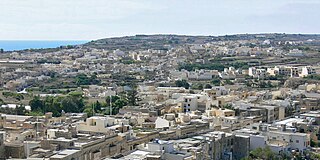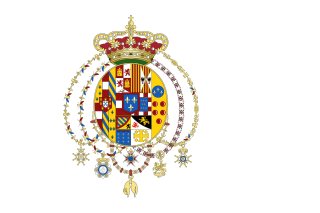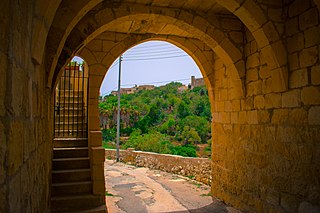
Victoria, also known among the native Maltese as Rabat or by its title Città Victoria, is an administrative unit of Malta, and the main town on Gozo. Victoria has a total population of 6,901, and is the most populous settlement in Gozo.

Kalkara is a village in the South Eastern Region of Malta, with a population of 3,014 as of March 2014. The name is derived from the Latin word for lime (Calce), and it is believed that there was a lime kiln present there since Roman times. Kalkara forms part of the inner harbour area and occupies the area around Kalkara Creek. The town has its own Local Council and is bordered by the cities of Birgu and Żabbar, as well as the town of Xgħajra.

The Basilica of the National Shrine of the Blessed Virgin of Ta' Pinu is a Roman Catholic minor basilica and national shrine located some 700 metres (2,300 ft) from the village of Għarb on the island of Gozo, the sister island of Malta.

Fontana is an administrative unit of Malta, on the island of Gozo, with a population of 985 people.

Ta' Kerċem is an administrative unit of Malta, on the island of Gozo, with a population of 1,938 people as of March 2014.

Marsalforn, also written as M'Forn for shortcut purposes, is a town on the north coast of Gozo, the second largest island of the Maltese archipelago. The town lies between the hilltop towns of Xagħra and Żebbuġ. Associated with this town there is also the bay of Qbajjar. The town is part of the Żebbuġ local council. Marsalforn is one of the most popular tourist resorts on Gozo. It is well served by hotels, guest houses, restaurants, bars, and beaches. There is only a small sandy beach in Marsalforn. However, along the rocky coastline there are a number of interesting swimming spots.
Xlendi is an urban village in Malta situated in the south west of the island of Gozo. It is surrounded by the villages of Munxar, Fontana and Kerċem. The village is administered by Munxar, but has its own coat of arms and motto. From March 2010, Xlendi has had its own 5-person "mini council" responsible for the main activities of the area.

Maltese architecture has its origins in prehistory, and some of the oldest free-standing structures on Earth – a series of megalithic temples – can be found on Malta. The islands were colonized by the Phoenicians and later the Romans, who established the cities of Melite and Gaulos. Although these were substantial settlements and are known to have had numerous temples, churches and palaces, few remains have survived apart from some architectural fragments.

The Citadel, also known as the Castello, is the citadel of Victoria on the island of Gozo, Malta. The area has been inhabited since the Bronze Age, and the site now occupied by the Cittadella is believed to have been the acropolis of the Punic-Roman city of Gaulos or Glauconis Civitas.

St. George's Basilica or the Basilica and Collegiate Parish Church of Saint George, also simply known as San Ġorġ in Maltese, is a historic Baroque church situated in the middle of Gozo, the second largest island in the Maltese archipelago, and is surrounded by a maze of old narrow streets and alleys. The church had been rebuilt numerous times during the Middle Ages. Today's basilica was built between 1672 and 1678.

In the small Mediterranean island nation of Malta, the predominant religion is Roman Catholicism.
This article details the history of religion in Malta. The Republic of Malta is a Southern European country consisting of an archipelago situated in the centre of the Mediterranean, 80 km south of Sicily, 284 km east of Tunisia and 333 km north of Libya, with Gibraltar 1,755 km to the west and Alexandria 1,508 km to the east. Malta covers just over 316 km2 in land area, making it one of the world's smallest states. It is also one of the most densely populated countries worldwide. Catholicism is the official religion in Malta as declared by the Maltese constitution.

The Gozitan Nation, commonly known as Gozo, was an unrecognised state located on the island of Gozo between 1798 and 1801 during the French Revolutionary Wars. It was a monarchy recognizing the authority of Ferdinand III of Sicily with a provisional government led by Governor-General Saverio Cassar. Its capital was Rabat. The country was established between 28 and 29 October 1798 from the territory of French-occupied Malta and was eventually incorporated into Malta Protectorate on 20 August 1801.

The Church of the Nativity of Our Lady, more commonly known in Maltese as Ta' Savina, is a church situated in the heart of Victoria, in the island of Gozo, part of the Maltese archipelago.

The Basilica of Our Lady of Mount Carmel is a Carmelite Roman Catholic minor basilica dedicated to Our Lady of Mount Carmel, located in Valletta, Malta. It is one of the major churches of Valletta, and it forms part of a UNESCO World Heritage Site which includes the entire city. The present church was constructed between 1958 and 1981 on the site of a late 16th century church which was destroyed during World War II.

The Chapel of the Annunciation is a Medieval Roman Catholic church located in Ħal-Millieri, limits of Żurrieq, Malta.

Lorenzo D'Astiria was a Spanish Roman Catholic bishop of Malta in the 17th century.

Ġużepp Portelli was a Maltese Roman Catholic prelate who founded the present Ta' Pinu Basilica in Gozo.

The Chapel of St. Paul the Hermit is a small church located in a cave in Wied il-Għasel, in Mosta, Malta.

Il-Lunzjata Valley is an agricultural valley located southwest of Victoria, Gozo. The valley is known for its lush fields and hospitaller-era chapel. Running freshwater is very common on the valley bottom during autumn and spring. This supply of freshwater is commonly put to use for the farming of crops in fields within the valley through a number of channels dug on the ground. The valley is also home to an old fountain that makes use of the freshwater which was restored in 2007. Lunzjata is also considered a Natura 2000 site.




















